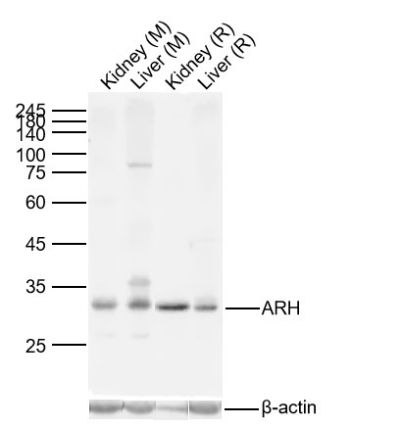The protein encoded by this gene is a cytosolic protein which contains a phosphotyrosine binding (PTD) domain. The PTD domain has been found to interact with the cytoplasmic tail of the LDL receptor. Mutations in this gene lead to LDL receptor malfunction and cause the disorder autosomal recessive hypercholesterolaemia.
Function:
Adapter protein (clathrin-associated sorting protein (CLASP)) required for efficient endocytosis of the LDL receptor (LDLR) in polarized cells such as hepatocytes and lymphocytes, but not in non-polarized cells (fibroblasts). May be required for LDL binding and internalization but not for receptor clustering in coated pits. May facilitate the endocytocis of LDLR and LDLR-LDL complexes from coated pits by stabilizing the interaction between the receptor and the structural components of the pits. May also be involved in the internalization of other LDLR family members. Binds to phosphoinositides, which regulate clathrin bud assembly at the cell surface.
Subunit:
Interacts with LDLR. Binds to soluble clathrin trimers. Interacts with AP2B1; the interaction mediates the association with the AP-2 complex. Interacts with VLDLR
Subcellular Location:
Cytoplasm.
Tissue Specificity:
Expressed at high levels in the kidney, liver, and placenta, with lower levels detectable in brain, heart, muscle, colon, spleen, intestine, lung, and leukocytes.
Post-translational modifications:
Phosphorylated upon DNA damage, probably by ATM or ATR.
DISEASE:
Defects in LDLRAP1 are the cause of autosomal recessive hypercholesterolemia (ARH) [MIM:603813]. ARH is a disorder caused by defective internalization of LDL receptors (LDLR) in the liver. ARH has the clinical features of familial hypercholesterolemia (FH) [MIM:143890] homozygotes, including severely elevated plasma LDL cholesterol, tuberous and tendon xanthomata, and premature atherosclerosis. LDL receptor (LDLR) activity measured in skin fibroblasts is normal, as the LDL binding ability.
Similarity:
Contains 1 PID domain.
SWISS:
Q5SW96
Gene ID:
26119
Database links:
Entrez Gene: 26119 Human
Entrez Gene: 100017 Mouse
Entrez Gene: 500564 Rat
Omim: 605747 Human
SwissProt: Q5SW96 Human
SwissProt: Q8C142 Mouse
Unigene: 590911 Human
Unigene: 482148 Mouse
| Picture |
Sample:
Lane 1: Mouse Kidney Lysates
Lane 2: Mouse Liver Lysates
Lane 3: Rat Kidney Lysates
Lane 4: Rat Liver Lysates
Primary: Anti-ARH (SL6337R) at 1/1000 dilution
Secondary: IRDye800CW Goat Anti-Rabbit IgG at 1/20000 dilution
Predicted band size: 34kDa
Observed band size: 34kDa
|
|
|
